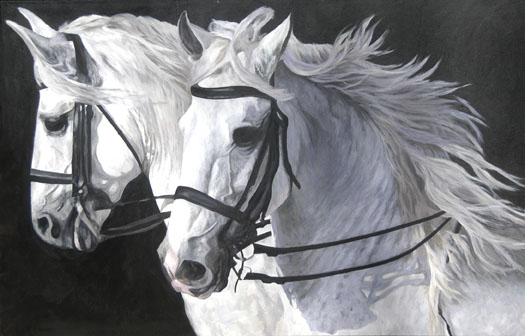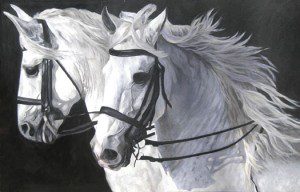
12 Feb HORSES: TELLURIDE GALLERY OF FINE ART
Opening reception Thursday
 Been to Greece? Even if not, you likely know the famous Parthenon frieze. Features horses. As does an upcoming show at the Telluride Gallery of Fine Art.
Been to Greece? Even if not, you likely know the famous Parthenon frieze. Features horses. As does an upcoming show at the Telluride Gallery of Fine Art.
Get ready to channel your inner cowboy. “HorseShow” includes works by Bernie Fuchs, Mark English, Nancy B. Frank, Adele Sypesteyn, and Jenny Gummersall. The opening reception of the exhibition takes place Thursday, February 16, 5:30 – 7:30 p.m. Nancy B. is in attendance.
The beginning of the depiction of horses in art history predates the written language of man, going back to prehistoric times. At Niaux, Lascaux, Vallon-ont-D’arc and other sites across France and Spain, places where ancient rock art is found, roughly one-third of the marks shape horses. Thirty thousand years before the birth of Christ, an artist was carving a horse amulet in bone. Equine images were common in ancient Egyptian, Grecian, and Roman art.
Fast forward to the Renaissance, the horse became a fixture in works of well known painters of the period, among them, Paolo Uccello, Albrecht Durer, Raphael, Andrea Mantegna, Titian, and Leonardo da Vinci. In the Baroque era, the tradition of equine portraiture was established, when artists such as Peter Paul Rubens Anthony van Dyck and Diego Velasquez put royals atop regal mounts.
Later, the 18th century, artists Theodore Gericault and Eugene Delacroix were Romantics who portrayed horses in many of their works. But the artist most associated with equines was George Stubbs (1724 – 1806).
Stubbs depicted the beauty and grace of horses without woozy sentimentality, but like all great artists, with the cool eye of an objective observer. (Stubbs had spent years dissenting and looking, and his anatomical studies of horses rival Leonardo’s anatomies.)
For Stubbs, the horse was a metaphor for social harmony. “Order on four legs,” said art historian Robert Hughes explaining the artist.
What is the horse to artists in the Gallery’s show?
“To me, Horses Are the American Western Landscape,” said Gummersall. (Caps are the artist’s.) “Their presence… dare(s) us to dream bigger, freer, more powerfully. They Dance. These hand-colored images echo the perceptions one experiences within these landscapes.”
“They are simply the most beautiful and captivating animals on earth,” said Sypesteyn. “To me, the horse is in a class all its own. It has a spirit, a grace, and a strength no other animal can come close to. Being in the presence of a horses transports me to a very magical place. I am in awe of them. And this is what I strive to capture in my work.”
“I wasn’t just a horse crazy kid, I thought I was a horse, snorting as I cantered ‘round the playground,” said Frank. “When my family drove past a nearby horse farm, I would hang out the window, excitedly exclaiming HORSES! Clearly I had a passion for horses, but thought them too clichéd to paint. But when I found my stride with a close-cropped style that filled the frame to abstraction, I was finally able to combine heart with technique in a format slightly different from the norm. You could say I finally hit my stride as an artist with my horse paintings.”
The depictions of horses in the show at the Telluride Gallery of Fine Art were sired by the Parthenon frieze and the distinguished history of the genre through Stubbs and other great interpreters.
Check out Clint Viebrock’s video to preview the variations on the historical/cultural theme:


Sorry, the comment form is closed at this time.